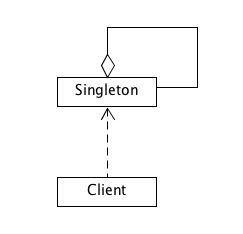
单例模式(Singleton)定义:一个类只能有一个实例,且该类能自行创建这个实例的模式。
单例模式有三个特点:
1、单例类只有1个实例对象。
2、该单例对象必须由单例类自己创建。
3、单例类对外提供一个访问该唯一实例的全局访问点。
懒加载实现,线程安全:
1 public class LazySingleton { 2 3 private static volatile LazySingleton lazySingleton = null; 4 5 private LazySingleton() { 6 7 } 8 9 public static synchronized LazySingleton getInstance() { 10 if (lazySingleton == null) { 11 lazySingleton = new LazySingleton(); 12 } 13 return lazySingleton; 14 } 15 }
饥饿式实现,线程安全:
1 public class HungrySingleton { 2 3 private static final HungrySingleton instance = new HungrySingleton(); 4 5 private HungrySingleton() { 6 7 } 8 9 public static HungrySingleton getInstance() { 10 return instance; 11 } 12 }
调用方式:
1 public class Client { 2 3 public static void main(String[] args) { 4 // TODO Auto-generated method stub 5 6 LazySingleton l1 = LazySingleton.getInstance(); 7 LazySingleton l2 = LazySingleton.getInstance(); 8 System.out.println(l1 == l2); 9 10 HungrySingleton h1 = HungrySingleton.getInstance(); 11 HungrySingleton h2 = HungrySingleton.getInstance(); 12 System.out.println(h1 == h2); 13 } 14 15 }
执行结果:

懒加载双重检查机制,线程安全:
1 public class MultiThreadSingleton { 2 3 private static volatile MultiThreadSingleton multiThreadsSingleton = null; 4 5 private MultiThreadSingleton() { 6 System.out.println("MultiThreadSingleton init"); 7 } 8 9 public static MultiThreadSingleton getInstance() { 10 if (multiThreadsSingleton == null) { 11 synchronized (MultiThreadSingleton.class) { 12 if (multiThreadsSingleton == null) { 13 multiThreadsSingleton = new MultiThreadSingleton(); 14 } 15 } 16 } 17 return multiThreadsSingleton; 18 } 19 20 public static void main(String[] args) { 21 // TODO Auto-generated method stub 22 for (int i = 0; i < 10; i++) { 23 new Thread(() -> { 24 MultiThreadSingleton.getInstance(); 25 }).start(); 26 } 27 28 } 29 }

